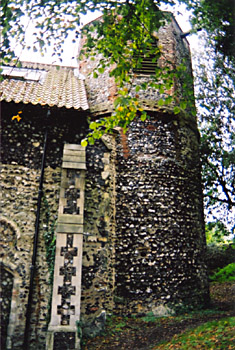
St. Etheldreda's round tower
Photo © S. Alsford
The dedication to an East Anglian queen who took up the religious life is itself suggestive for there having been a church on the site in the late Anglo-Saxon period. On the other hand, it is possible the church had a connection with Ely abbey, with which Etheldreda was associated, through garrison duty at the Norman castle (a small stone plaque embedded in the south wall appears to depict a mounted knight); the abbot of Ely is said to have held a stone tower in Norwich. The flint round tower – often considered an Anglo-Saxon architectural feature – has indications of Norman work, as do some of the church walls. Therefore the present building is unlikely to be earlier than late eleventh century. The upper, octagonal part of the tower is a Tudor replacement or refurbishment.

From Corbridge's map of 1724.